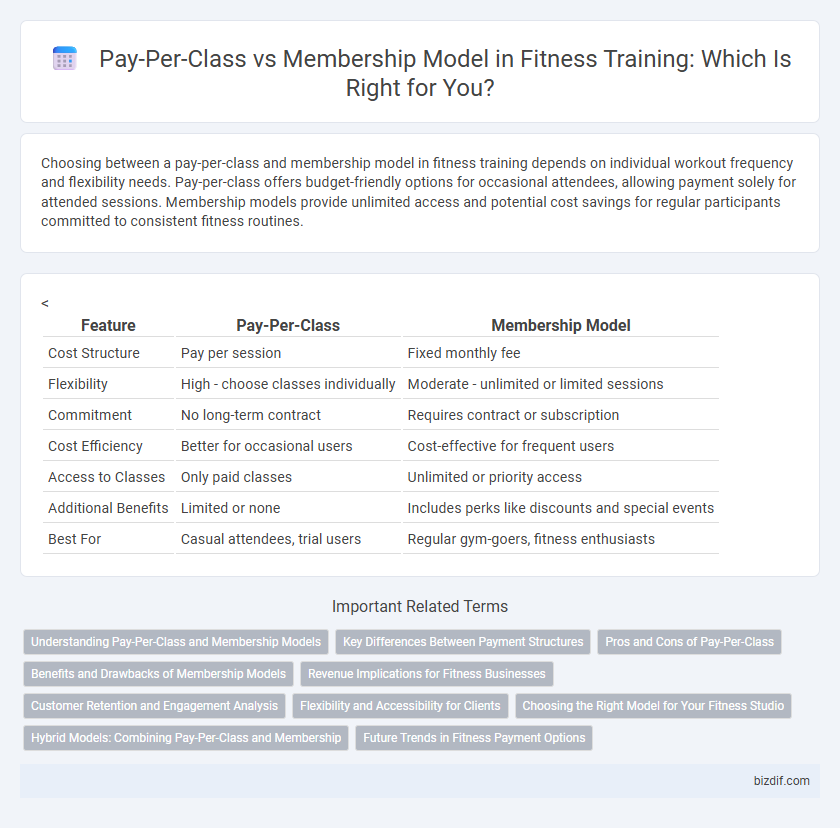Choosing between a pay-per-class and membership model in fitness training depends on individual workout frequency and flexibility needs. Pay-per-class offers budget-friendly options for occasional attendees, allowing payment solely for attended sessions. Membership models provide unlimited access and potential cost savings for regular participants committed to consistent fitness routines.
Table of Comparison
| Feature | Pay-Per-Class | Membership Model |
|---|---|---|
| Cost Structure | Pay per session | Fixed monthly fee |
| Flexibility | <High - choose classes individually | Moderate - unlimited or limited sessions |
| Commitment | No long-term contract | Requires contract or subscription |
| Cost Efficiency | Better for occasional users | Cost-effective for frequent users |
| Access to Classes | Only paid classes | Unlimited or priority access |
| Additional Benefits | Limited or none | Includes perks like discounts and special events |
| Best For | Casual attendees, trial users | Regular gym-goers, fitness enthusiasts |
Understanding Pay-Per-Class and Membership Models
The pay-per-class model allows clients to pay individually for each fitness session, offering flexibility without long-term commitments, ideal for those with irregular schedules. Membership models provide unlimited access to classes for a fixed monthly or annual fee, encouraging consistent attendance and fostering community engagement. Choosing between these models depends on factors like workout frequency, budget, and commitment level, influencing both user experience and gym revenue stability.
Key Differences Between Payment Structures
Pay-per-class offers flexibility by allowing clients to pay individually for each session, ideal for sporadic attendance without long-term commitment. Membership models provide predictable revenue through recurring payments, often including unlimited access or discounts on classes, fostering client loyalty and consistent participation. Understanding these payment structures helps fitness centers balance cash flow management with customer retention strategies.
Pros and Cons of Pay-Per-Class
Pay-per-class fitness training offers flexibility by allowing users to pay only for the classes they attend, which is ideal for those with irregular schedules or specific workout preferences. This model provides a cost-effective option without long-term commitments, but it can become expensive for frequent attendees compared to membership plans. The lack of consistent access and potential higher per-session costs may limit sustained fitness progress for dedicated individuals.
Benefits and Drawbacks of Membership Models
Membership models offer consistent revenue for gyms and unlimited access to classes for members, promoting regular attendance and long-term fitness goals. However, these models can lead to underutilization if members pay but seldom attend, reducing perceived value. Commitment to membership fees may deter occasional users seeking flexibility or short-term engagement in fitness training.
Revenue Implications for Fitness Businesses
The Pay-Per-Class model generates immediate revenue with each session, offering flexibility but potential income variability for fitness businesses. The Membership Model secures steady, predictable cash flow through monthly or annual fees, boosting long-term financial stability. Fitness businesses often balance both strategies to maximize revenue while catering to diverse customer preferences.
Customer Retention and Engagement Analysis
Pay-per-class models offer flexibility but often result in lower customer retention due to lack of commitment incentives, while membership models foster consistent engagement through recurring payments and exclusive benefits. Data shows membership clients typically attend 30% more classes monthly, enhancing fitness outcomes and long-term loyalty. Engagement metrics such as attendance frequency, class variety participation, and app interaction rates are significantly higher within membership programs, indicating stronger customer retention and satisfaction.
Flexibility and Accessibility for Clients
The pay-per-class model offers clients maximum flexibility by allowing them to attend sessions without long-term commitments, ideal for varying schedules and fitness needs. Membership models provide consistent access and potential cost savings but may limit spontaneous attendance due to fixed payment structures. Clients prioritizing adaptable workout timing and diverse class choices often prefer pay-per-class options over memberships.
Choosing the Right Model for Your Fitness Studio
Selecting the right payment model for your fitness studio significantly impacts revenue consistency and client retention. A pay-per-class model offers flexibility and attracts occasional attendees, while a membership model ensures steady cash flow and fosters long-term commitment. Evaluate your target market's preferences, class frequency, and operational costs to determine whether a subscription-based membership or a per-class fee structure aligns best with your business goals.
Hybrid Models: Combining Pay-Per-Class and Membership
Hybrid fitness models blend pay-per-class flexibility with membership benefits, offering clients tailored workout options and predictable costs. This approach increases client retention by accommodating diverse schedules and commitment levels while maximizing studio revenue. Data shows hybrid models can boost customer satisfaction rates by up to 30% compared to traditional single-payment systems.
Future Trends in Fitness Payment Options
Fitness payment options are evolving with an increasing shift towards hybrid models combining Pay-Per-Class flexibility and Membership Model convenience to meet diverse consumer preferences. Emerging technologies such as blockchain and mobile wallets enhance secure, real-time transactions, supporting seamless integration of class passes and subscription services. Data analytics and AI-driven personalization enable fitness providers to tailor payment plans dynamically, optimizing revenue streams and improving user engagement in a competitive market.
Pay-Per-Class vs Membership Model Infographic

 bizdif.com
bizdif.com